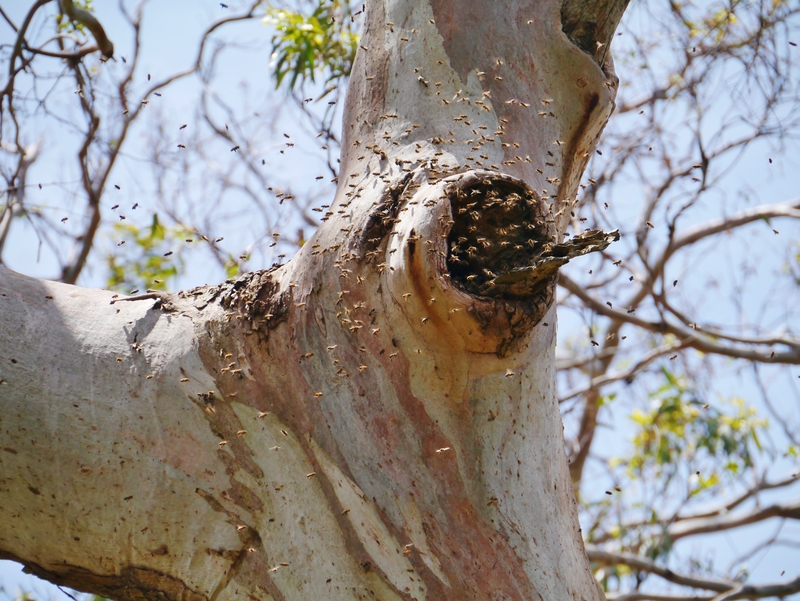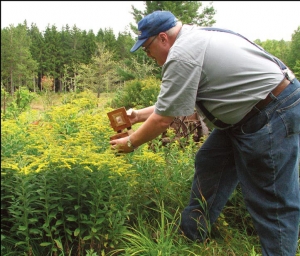There are a couple of important steps to remember for “beelining”: mix the correct artificial nectar (see below for the recipe) and pick the correct place to wait for a bee to come by. This might take some research on your own first. Your nectar needs to be sitting in a field where bees are already foraging. Otherwise, you'll be waiting for hours on end. It's recommended that you check the potential field often to ensure the bees feed on the flower nectar there. Also, be conscious of whether or not your neighbors have domesticated beehives because you could be following a beeline that leads straight into their yard instead of into the wild.
Loaded for bees
You’ll need the following pieces of equipment: a bee box; a 2 × 3-inch piece of empty honeycomb (this can be obtained from a beekeeper); some artificial nectar; a stick about 1 inch thick and 5 feet long, sharpened at one end (you can also use a crowbar); a compass; a watch; a brightly colored hat with sun brim; and a pair of binoculars. Optional are a GPS receiver and a computer with a topographical mapping program (I use DeLorme Topo USA and Topo Tools).
I like to wear a light colored shirt and a blue hat. I want to be highly visible to the bees, as they’ll be using me as a landmark to return to the bee box the first few times.
The honeybee’s favorite foods in my area include white clover, goldenrod, and milkweed. I have had my best luck lining bees in late August and early September.
Mix up a batch of artificial nectar. I use plain granulated sugar and water with a touch of honey. Use about 1 teaspoon of honey for every 2 tablespoons of sugar. Add enough water to completely dissolve the sugar and honey. Make about ¼ cup of this mixture. Put your piece of honeycomb in the bottom of the box and spoon the sugar water into it until the cells are full.
Find a field where honeybees are foraging and seek out an open spot with low vegetation, as close to the foraging honeybees as possible, where you can sit on the ground and see the sky in all directions. Firmly drive the pointed end of your stick into the ground here.
To Catch a Bee
You now need to catch a honeybee in your box without hurting her. Keep the center partition closed tight, with the honeycomb full of sugar water in the bottom compartment. Carefully approach a honeybee, and in a smooth, fluid upward movement, sweep the bee off the flower into the box and snap the cover shut.
When you’re successful, you’ll have a honeybee trapped in the top of your box. Slide open the center partition, making sure not to let the partition (and bee) come all the way out of the box. The goal now is to get the bee into the bottom compartment with the honeycomb and to keep her there long enough that she will start feeding on the sugar water. I do this by holding one hand over the top of the box to cover the window, and using the other to hold the box and the slide open, raise the box high, then accelerate it downward, stopping abruptly.
Immediately close the partition all the way and look into the window to see if the bee has dropped to the bottom compartment. If she hasn’t, open the partition and try again. If she has, move over to your stick and gently hang the box on it.
Once the bee has stopped buzzing, open the top cover, then very carefully slide open the partition and leave it hanging just into the box. If you’re lucky, the bee will emerge after one or two minutes, fly all around the box for a few seconds before suddenly heading off in one direction toward her colony.
The Wait
When the bee leaves the box, mark the time. Remain seated where you are and wait; if she returns, she’ll use you as a visible reference to help find the box. Upon her return, the bee will zoom around you several times. Mark the time the bee returns. You now have a rough idea how far away the hive is.
The bee will probably keep repeating this feeding routine as long as the box is there with food. Continue to watch the bee(s) coming and going until you’re confident of the exact line she takes, and the round-trip time; then take a compass bearing on the line. If it takes under 3 minutes for the bee to make the round trip to the hive, the bee tree is close, probably under a quarter-mile.
“Lining”
If it seems that the tree is close, you can simply start walking on the “line,” using your compass. Investigate any tree holes and cavities. Keep your ears open, too.
If the bee takes more than 10 minutes to make the round trip, try to catch another bee closer to the tree. I mark into my GPS receiver the two (or more) locations where I catch bees, then transfer these coordinates to a mapping program on my computer. I draw lines and look for the hive at their intersection.
Another method that may help is moving the bee closer to the tree. You can move the box to another open area that is directly on the bee line. At the new location, open the slider and let the bee feed, and, as before, observe the bee line.
If you find the tree you’re searching for, mark the location in your GPS and put it on your computer map.
Have you been able to find a wild hive using a beeline? Let us know if you have any additional advice!
Article and Photo Source: Northern Woodlands

